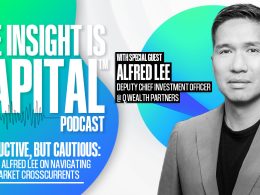A Qualified Plan Opportunity for Advisors
by Commonwealth Financial Network
 Did you know there's a qualified plan opportunity for advisors who work with business owners? It's called the cash balance plan, and it's growing in popularity among small and midsize businesses. But what's behind this budding interest in cash balance plans? How do they work? And what are the benefits for you and your business owner clients?
Did you know there's a qualified plan opportunity for advisors who work with business owners? It's called the cash balance plan, and it's growing in popularity among small and midsize businesses. But what's behind this budding interest in cash balance plans? How do they work? And what are the benefits for you and your business owner clients?
According to the 2016 National Cash Balance Research Report, "cash balance plans make up 29% of all defined benefit plans, compared with 2.9% in 2001." Here is what's driving this growth:
- Rising taxes
- "Hybrid" appeal (i.e., high contribution limits combined with the flexibility and portability of a 401(k) plan)
- Legislative changes (e.g., 2006 Pension Protection Act, IRS cash balance regulations)
- Dearth of retirement savings
Given this rising popularity, why not explore how this segment of the qualified plan market could help your business—and your business owner clients? Let's start by defining the cash balance plan.
The cash balance plan is a defined benefit plan with features of both a traditional pension plan and a pooled profit-sharing plan. Rather than defining an employee's benefit as a series of monthly payments made in retirement (e.g., 60 percent of the employee's highest three years of compensation), however, the cash balance plan defines the benefit as a stated account balance.
With a cash balance plan, a participant's account can grow in two ways:
- Annual company contribution. The employer contributes a percentage of pay or a flat dollar amount to the participant's account.
- Annual interest credit. For most cash balance plans, the assumed rate of return is based on the 30-year Treasury bond. This rate changes annually, but a 4-percent interest credit has been typical in recent years.
Formally recognized by the Pension Protection Act of 2006, these qualified plans enjoy IRS tax-favored status. Plus, tax advisors generally agree that these plans should be funded to their maximum before exploring other tax-efficient strategies.
Sound interesting? Indeed. Before recommending these plans to your clients, however, there are a few more important points to keep in mind.
Investment management. Investments are managed by the employer or financial advisor, not by plan participants. Because employees can't direct their investments, you can manage the assets on your firm's platform. So if you're a wealth management-focused advisor, the cash balance plan could be an ideal product. Keep in mind, though, that to provide investment advisory services to a qualified plan, your firm may require that you hold a particular designation (e.g., the Accredited Investment Fiduciary®).
Plan contributions. Contributions are subject to IRS limits and are determined by a formula specified in the plan document. Plus, annual contributions are age dependent. Specifically, the older the participant (or business owner), the higher the allowed contributions. Why? An older person has fewer years to save toward the approximate $2.6 million lump sum allowed.
Assets under management. A cash balance plan is funded annually and over a number of years, so this funding may have a significant impact on your assets under management and revenue year after year. A $1 million IRA, on the other hand, will generally provide a one-time increase to your assets under management.
Distribution options. Plan balances are portable. Business owners may try fully funding their cash balance plans until they retire or sell their businesses. Upon retirement, they can roll over account balances to IRAs or other qualified retirement plans. Proceeds can also be paid as annuities or lump-sum distributions.
Plan combinations. Cash balance plans can be offered in addition to 401(k) or other plans, producing larger contribution amounts. A 401(k) in combination with a cash balance plan may be ideal for many companies and partnerships.
Participation. Not everyone must participate equally in a cash balance plan. Employers can contribute different amounts for each participant (a percentage of pay or a flat dollar amount). For example, business owners can target contributions to themselves or key executives whom they want to retain or incentivize.
Tax savings. Implementing and funding a cash balance plan could substantially increase tax-deductible contributions, resulting in significant tax savings to participants. Cash balance contributions could reduce both taxable income and adjusted gross income, so high-income earners may move into a lower tax bracket. With increased taxes and new taxes implemented at the federal, state, and local tax levels, tax savings from contributions into cash balance plans and subsequent earnings can be significant.
Protection from creditors. Cash balance plan assets (and all other qualified plan assets) are protected from creditors in case of bankruptcy. Business owners and partners can move assets from their businesses to their plans—where the assets are shielded from creditors and can be used as retirement nest eggs or passed on to heirs.
Both employers and employees may be the ideal clients for this type of plan.
Business partners or owners who want to contribute more than $50,000 per year to their retirement accounts. Many professionals and entrepreneurs neglect personal retirement accounts while building their practices or companies and need to catch up on retirement savings. Acceleration of savings is allowed in cash balance plans, with possible pretax contributions from $100,000 to $240,000 annually, based on an individual's age.
Companies already contributing to employees' retirement savings or willing to do so. These plans are often established for key executives and highly compensated employees but are also suitable for others. A cash balance plan typically provides a minimum company contribution of 3 percent to 4 percent for staff, on top of 5 percent to 7.5 percent of pay in a separate 401(k) profit-sharing plan.
Companies with consistent profit patterns. Because a cash balance plan is a pension plan with required employer contributions, consistent cash flow and profits are essential.
Last but certainly not least, there are many ways that the cash balance plan could work for you:
- With a higher contribution threshold than a 401(k), a cash balance plan can significantly affect your assets under management and perhaps your payout at your firm.
- Time and energy can be devoted to working with business owners and other executives, with limited interaction with plan participants, since participants don't manage their own accounts.
- Your clients can catch up on retirement savings—potentially contributing 10 years of savings in 3–5 years.
- This plan can be an effective tax planning tool. Business owners may move assets from the business to the plan, shielding assets from creditors and helping save on federal and state income taxes. This can lead to more assets for you to oversee.
With all of these benefits, combined with its growing popularity, the cash balance plan provides an entrée into the qualified retirement plan market in a way that is manageable for your practice. Are you ready to seize the opportunity?
Have you seen increased interest in cash balance plans among your clients? How have these plans benefited your business? Please share your thoughts with us below!
Editor's Note: This post was originally published in April 2015, but we've updated it to bring you more relevant and timely information.
Commonwealth Financial Network is the nation’s largest privately held independent broker/dealer-RIA. This post originally appeared on Commonwealth Independent Advisor, the firm’s corporate blog.
Copyright © Commonwealth Financial Network
















